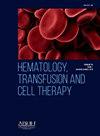Functional characterization of compound heterozygosity Hb S/Hb Deer Lodge in Brazil
IF 1.8
Q3 HEMATOLOGY
引用次数: 0
Abstract
Introduction
The Hb Deer Lodge (β2 His>Arg; HBB:c.8A>G) is a structural hemoglobin variant described in some populations around the world, characterized by increased oxygen affinity, but does not confer clinical symptoms to its carriers. The coinheritance of the Hb Deer Lodge with the most common hemoglobin variant, Hb S, has been reported only once; however, functional data were not described. Here we show a case of the Hb S and Hb Deer Lodge carrier in heterozygosity.
Methods
The Hb S and Hb Deer Lodge association was identified by High-Performance Liquid Chromatography (HPLC), reverse phase HPLC and the β globin gene sequencing. The functional characterization of this interaction was obtained using the O2 dissociation curve, determination of the cooperativity between the globin chains and the Bohr effect in the presence and absence of organic phosphates.
Results
When the Hb S and Hb Deer Lodge were associated, there was a decrease in cooperativity, no significant changes in oxygen affinity and no significant Bohr effect changes.
Conclusion
Despite these genetic variations, the carrier showed no hematological alterations and no clinical symptoms, possibly due to the high oxygen affinity of the Hb Deer Lodge, which interferes with the Hb S polymerization.
巴西 Hb S/Hb Deer Lodge 复合杂合子的功能特征
Hb鹿屋(β2 His>Arg;HBB:c.8A>;G)是在世界各地的一些人群中发现的一种结构性血红蛋白变异,其特征是氧亲和力增加,但其携带者不会产生临床症状。鹿氏血红蛋白与最常见的血红蛋白变异Hb S的共遗传仅报道过一次;然而,没有描述功能数据。在这里,我们展示了Hb S和Hb Deer Lodge载体的杂合性。方法采用高效液相色谱法(HPLC)、反相高效液相色谱法(HPLC)和β珠蛋白基因测序法对Hb S和Hb Deer Lodge进行关联鉴定。通过O2解离曲线、珠蛋白链间的协同性测定以及有机磷酸盐存在和不存在时的玻尔效应,得到了这种相互作用的功能表征。结果Hb S与Hb Deer Lodge结合时,协同性降低,氧亲和力无明显变化,波尔效应无明显变化。结论尽管存在这些遗传变异,但携带者未表现出血液学改变和临床症状,这可能是由于Hb Deer Lodge的高氧亲和力干扰了Hb S聚合。
本文章由计算机程序翻译,如有差异,请以英文原文为准。
求助全文
约1分钟内获得全文
求助全文
来源期刊

Hematology, Transfusion and Cell Therapy
Multiple-
CiteScore
2.40
自引率
4.80%
发文量
1419
审稿时长
30 weeks
 求助内容:
求助内容: 应助结果提醒方式:
应助结果提醒方式:


